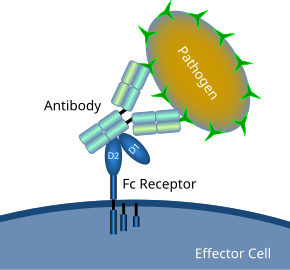Immune receptor

An immune receptor (or immunologic receptor) is a receptor, usually on a cell membrane, which binds to a ligand (usually another protein, such as cytokine) and causes a response in the immune system.
Types
The main receptors in the immune system are pattern recognition receptors (PRRs), Toll-like receptors (TLRs), killer activated and killer inhibitor receptors (KARs and KIRs), complement receptors, Fc receptors, B cell receptors and T cell receptors.[1]
| Receptor | Bind to [1] | Function[1] |
|---|---|---|
| Pattern recognition receptors (PRRs) (e.g. TLRs, NLRs) |
Pathogen-associated molecular patterns (PAMP) | Mediate cytokine production → inflammation → destroying pathogen |
| Killer activated and killer inhibitor receptors (KARs and KIRs) | Avails NK cells to identify abnormal host cells (KAR) or inhibit inappropriate host cell destruction (KIR) | |
| Complement receptors | Complement proteins on e.g. microbes | Allow phagocytic and B cells to recognize microbes and immune complexes |
| Fc receptors | Epitope-antibody complexes | Stimulate phagocytosis |
| B cell receptors | Epitopes | B cell differentiation into plasma cells and proliferation |
| T cell receptors | Linear epitopes bound to MHC | Activate T cells |
| Cytokine receptors | Cytokines | Regulation and co-ordination of immune responses |
See also
References
External links
- Immunologic + receptor at the U.S. National Library of Medicine Medical Subject Headings (MeSH)
